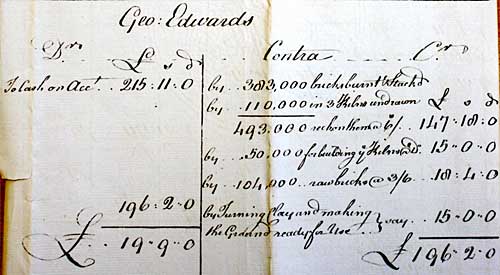Jane Bethell discovers how bricks were made by hand in the 1770s to build the canal locks and bridges.
Nowadays we are asked to buy a brick to help restore the canal, and it arrives on a lorry without us needing to know how it was made. But have you thought how different things were in the 1770's when the canal was being built. Bricks then were made on site where suitable clay was available, with the clay being dug and moulded by hand. Each piece of clay was turned each day to aid drying, and then stacked in a specially built kiln. More effort was required to collect and unload the coal needed to fire the kiln, and while the firing was taking place, the operator had to stay up all night to tend it.
The Stroudwater archive opens a wonderful window on these activities. In Minute Book 1, there is an entry ordering Mr Grazebrook, the company clerk, to check if the clay that had been dug was suitable for brick making, and a later entry appointed Mr Maskell and Mr Edwards to make bricks. Mr Grazebrook's cash book has records of them being paid. A single sheet of paper found in one of the bundles of loose documents shows that they needed about 300,000 bricks per lock.


The biggest producer was Edwards. His account shows that he had almost half a million bricks made and another 100,000 in production.
Another single sheet is headed "State of the brick works 24th July 1777". From this, you can see that Mr Barnard, the established local brick maker from Frampton on Severn, with his single kiln, could not keep up with the demand. He had about 140,000 in production - not enough for even one lock. George Maskell and George Edwards between them built and ran five extra kilns to supply the lock builders. Note I say 'built the kilns' as the document shows they were being paid for the bricks need to build the kilns. Maskell had a kiln at Wallbridge and one at Stonehouse, and he had some 200,000 bricks in stock.
Other documents suggest there may have been more than these six kilns along the length of the navigation, and in the end the Company had a surplus of bricks which they had to sell (at a profit) as they needed the money. The price of the bricks was 6 shillings (30p) a thousand, which may seem cheap but it is hardly different from modern prices when the value of money is taken into account. However, the level of manual effort is very different today, and I am sure that modern restorers are glad they do not have to make their own bricks.